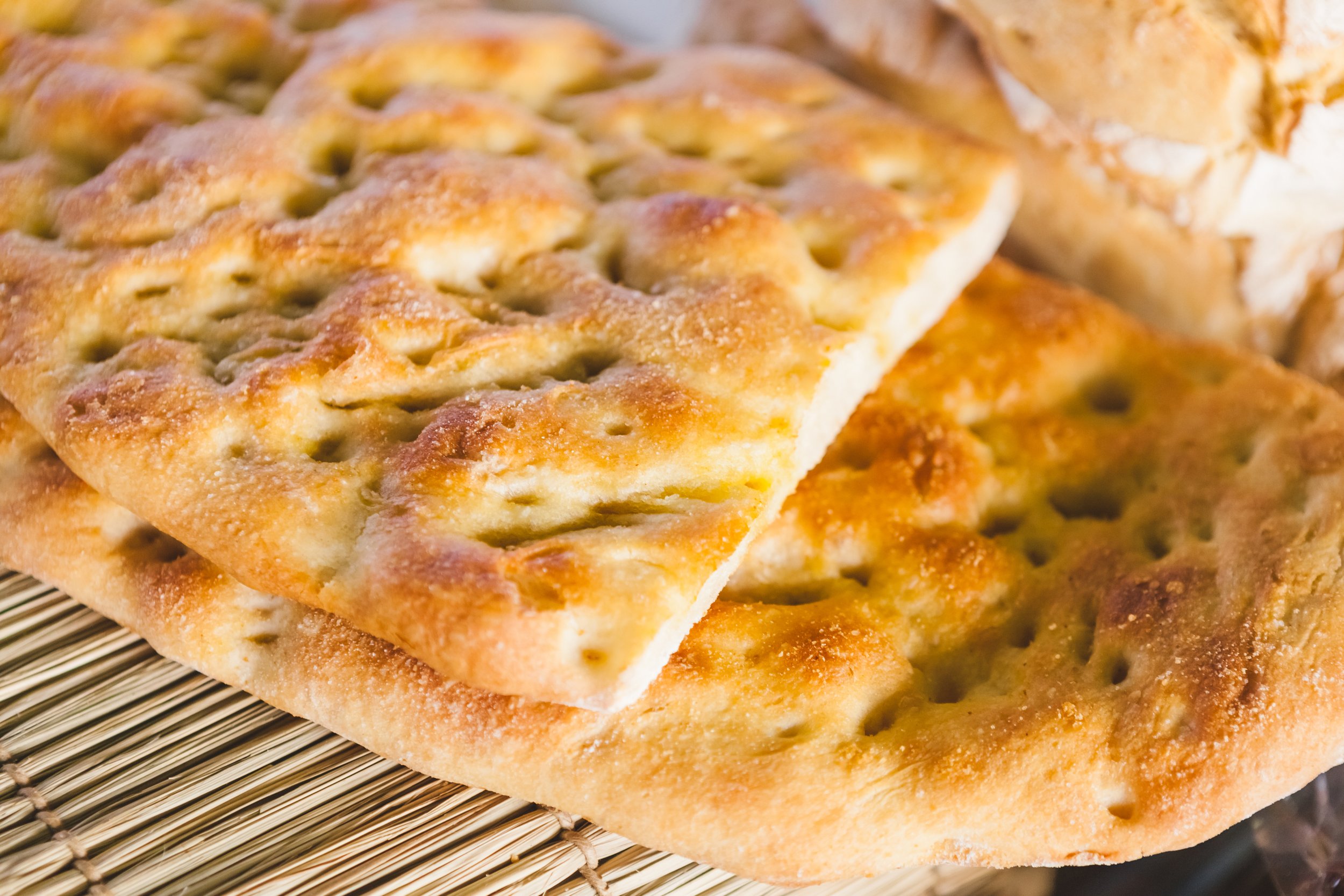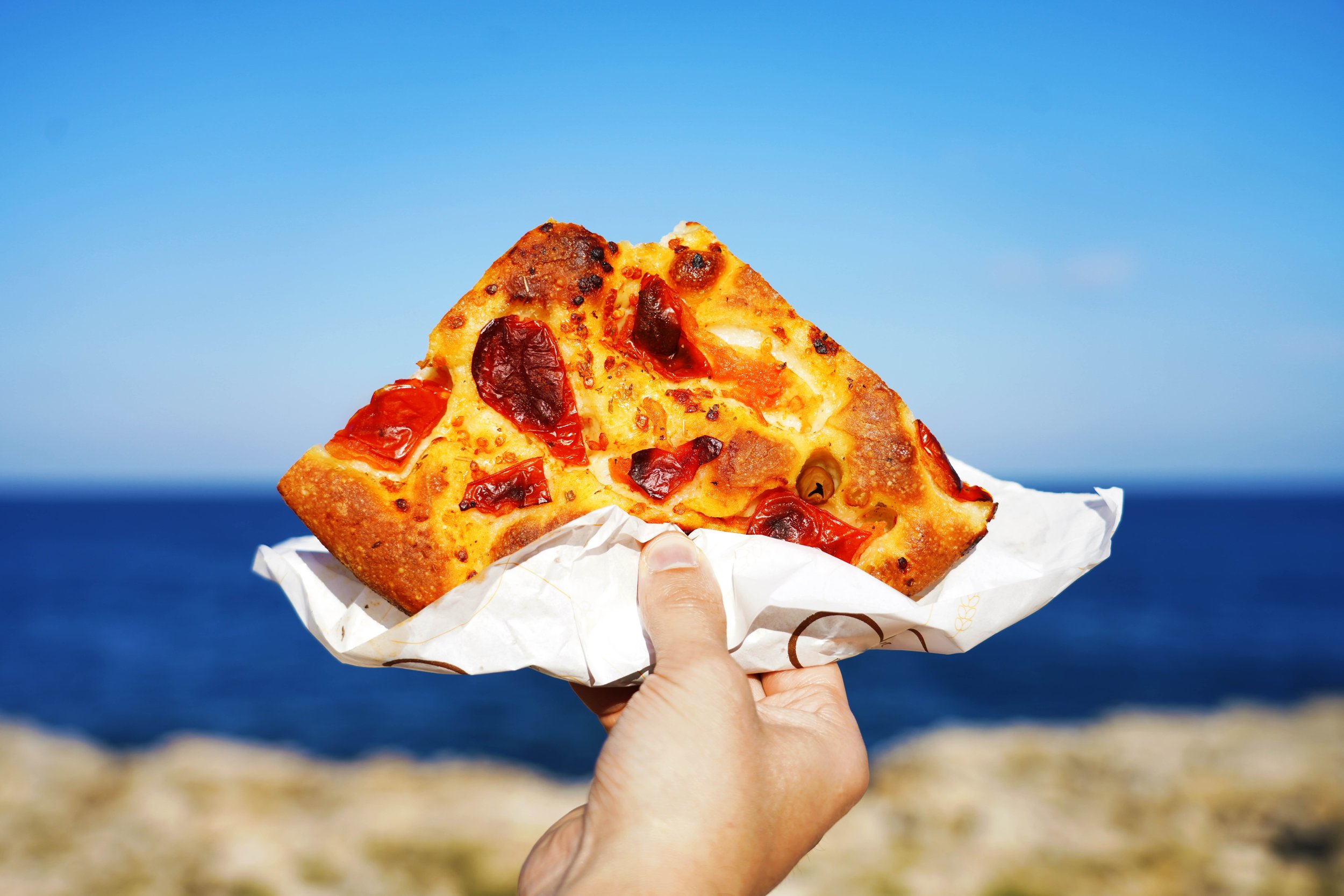A slice of focaccia:
A guide to Italy’s focaccias, from north to south
WRITTEN BY SOLVEIG STEINHARDT
Florence-born travel writer who loves street food, Bach, beaches, underrated cities, and architecture. You can find more of her writing here.
Simplicity is one of the secrets of Italian cuisine, and focaccia is here to prove it: this flat and delicious baked good, a perfect accompaniment to a slice of cheese, tomato sauce, or even Nutella, is made with only five ingredients: flour, water, salt, yeast, and olive oil. Yet, it is Italy’s number-one snack and a beloved lunchbox addition for most Italian schoolchildren.
Though it’s been around since the Phoenician era, focaccia owes its name to the Romans, with the word deriving from the Latin “focus”, or “fire”. In Roman times, focaccia was commonly offered to the gods during religious rituals, and this celebratory purpose was passed on throughout the ages until the Renaissance: in 15th-century Genoa, focaccias were offered in church during wedding and funeral services – until the habit got so out of hand that the church had to ban the tradition in order to stop all the noisy munching during solemn services.
In order to qualify as focaccia, Italy’s favorite flatbread has to be golden and crunchy on the outside and soft and “crumbless” on the inside – and less than an inch thick. But just like most Italian foods, it too comes in many different regional varieties. And though the basic list of ingredients usually remains the same (with a few additions in the south), it is the combination of the quantities, the type of oven used, the way the tray is greased, or the shape given to the dough that determine its different textures, colors, and thicknesses.
Here’s a quick guide to Italy’s most delicious focaccias, from the Alps to Sicily
Fügassa genovese
Liguria
Focaccia Genovese. Image Credit: Shutterstock
The traditional Genoese variety is considered “the mother of all focaccias” and it’s made with the basic five ingredients mentioned above to obtain a flatbread that is crunchy and greasy on the outside and soft on the inside, sometimes with the addition of small slices of onion. Compared to other Italian varieties, Genoese focaccia is relatively thick (around 2cm), but some Genoa neighborhoods such as Voltri are
known for their thinner version, which is slightly crunchy. The nearby town of Recco has made its focaccia a real specialty: unleavened to obtain an extremely thin bread, it is baked with formaggio di Recco on top – a real attraction for people visiting the town.
schiacciata
Tuscany
Schiacciata. Image Credit: Shutterstock
A very close relative of the Ligurian focaccia is Tuscany’s schiacciata. The name itself, which means “flattened,” refers to the need to flatten the dough by hand, making sure to leave finger marks all throughout to guarantee the irregular texture. Schiacciata dough is made with the same basic ingredients as its Ligurian cousin, but with a higher percentage of water and more olive oil, both inside the dough and
rubbed around it before it goes in the oven. Some bakers will also add a drop of wine to the mix for extra acidity. The result is more chewy and less spongy, with a golden, uneven crust that well retains the olive oil.
Pizza Bianca
Lazio (Rome)
Pizza Bianca. Image Credit: Shutterstock
Focaccia or pizza? At first glance, Rome’s pizza bianca looks a lot like Tuscan schiacciata but, as some would argue, it’s not really focaccia at all! It’s rather a well-hydrated, topping-less pizza. With a different texture and a lower amount of greasiness, pizza bianca is best enjoyed filled with bresaola and rucola or Rome’s traditional scarola salad.
Focaccia Pugliese
Puglia
Focaccia Barese. Image credit: Shutterstock
In southern Italian tradition, focaccias tend to be richer and topped with vegetables and herbs, becoming less of accompaniment and more of a meal. For example, the dough of the focaccia barese typically contains boiled potatoes and semolina, resulting in a thicker and softer bread that is baked with a topping of tomatoes, olives, and oregano. A little further south, Salento’s sceblasti are typical focaccia-like mini-pies made from a multi-ingredient dough that also combines cooked pumpkin dice, olives, onions, zucchini, and capers. This rich mix is then made into cookie sized and irregularly shaped pies that are baked in a wood-fired oven and eaten warm.
Red chili focaccia and sfincione
Calabria and Sicily
Sfincione. Image Credit: Shutterstock
Sicily and Calabria’s focaccias perfectly embody their local culinary traditions. So while the dough for Calabria’s soft and bright-red grupariata di Luzzi is made with the chili peppers this area is famous for (and then topped with anchovies, tomato and oregano), the small, doughnut-shaped pitta di Catanzaro is used as a base for Calabria’s most traditional specialties, such as ‘nduja (a spicy type of salami), provola cheese, anchovies, and the many different traditional sottoli (oil-preserved vegetables). Palermo’s sfincione, even richer and more similar to pizza, is a favorite street food all around the island, and is sold by street vendors in their three-wheeled Piaggio Ape cars. With a dough made with semolina, sugar, and lard instead of oil (vegetarians beware!), sfincione has a thicker and softer texture that blends very well with the oregano-flavored tomato sauce topped with tuma or caciocavallo cheese, anchovies, scarola, tomato, garlic, and oregano. The perfect summary of all of Sicily’s flavors in just one pie.









